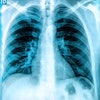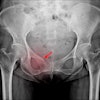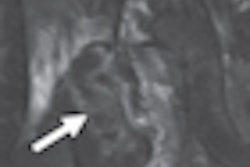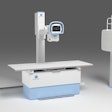A motion detector that monitors newborn infants as they sleep may someday double as a respiratory gating device capable of reducing repeat digital radiographs for squirming children and uncooperative adults.
"When time could mean life" is the slogan for Babysense, an electronic device that monitors infants while they are unattended in their cribs. It's designed to warn parents about the possible onset of sudden infant death syndrome (SIDS), a condition responsible for about five deaths in the U.S. for every 1 million apparently normal births.
Babysense is marketed internationally by Hisense of Rishon Le-Zion, Israel, and can be purchased over the Internet for about $130. Its key components include dual sensors that are placed under the crib mattress to monitor motion. The sensors are attached to controls that sound an alarm when the baby stops breathing.
One radiologist, Dr. Aviv Hirschenbein, recognized that Babysense might have medical imaging applications. For example, it could be used to control the timing of image acquisition without needing the typical bulky hardware that leads radiologists to rule out respiratory gating for their smallest patients.
Hirschenbein shared the idea with Dr. Gabriel Bartal, chairman of radiology at Meir Medical Center in Kfar Saba, Israel. Working with other radiologists at the facility, they collaborated on a phantom study that demonstrated significantly higher quality for digital radiography (DR) studies gated with Babysense than with ungated imaging. Their findings were presented at the 2009 RSNA annual meeting.
Imaging was performed with the motion-sensing device attached to a DR system (SmartRad, CMT Medical Technologies, Yoqneam, Israel). The sensors were positioned under an anthropomorphic chest phantom programmed to cycle between three seconds of simulated breathing and three seconds without movement.
Ten images were acquired using Babysense, and another 10 were acquired without gating while the operator attempted to manually capture images while the phantom was still.
Three experienced radiologists graded the images on a five-point scale, with 5 equaling the best image quality. The average score for Babysense gated images was 3.23, a significant improvement over the 2.32 score for the ungated acquisitions (p < 0.001), according to Bartal.
"Gating is the name of the game," Bartal said in a phone interview. "The DR system communicated with the motion sensor device to allow image taking only when there was no expected breathing at that time."
The findings promise to reduce the need for retakes when imaging often-uncooperative infants. Fewer retakes would translate into less ionizing radiation exposure for particularly susceptible patients, he said.
Early experience also suggests that a clinical version of Babysense could work with many makes and models of DR equipment. The gating technique could also improve the quality of imaging for uncooperative adults and elderly patients, he noted.
The study's findings were limited by its reliance on a mechanical phantom that simulated a uniform pattern of respiration and lack of movement. The device was not tested during nonuniform breathing, Bartal said.
By James Brice
AuntMinnie.com contributing writer
April 7, 2010
Copyright © 2010 AuntMinnie.com



















